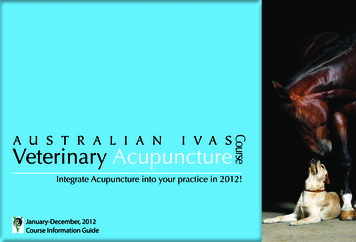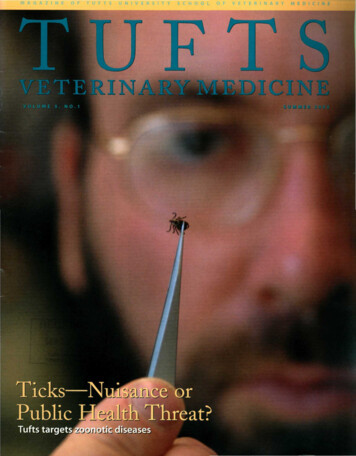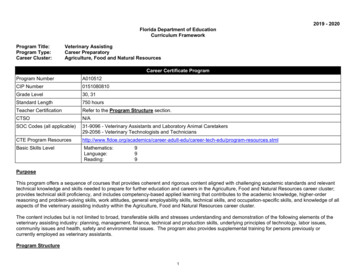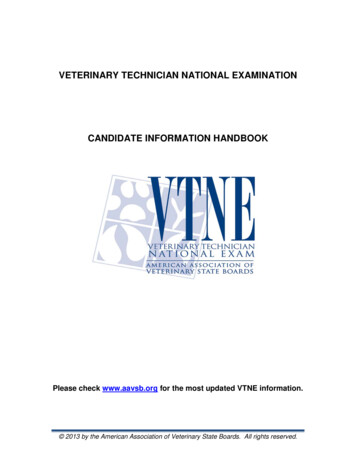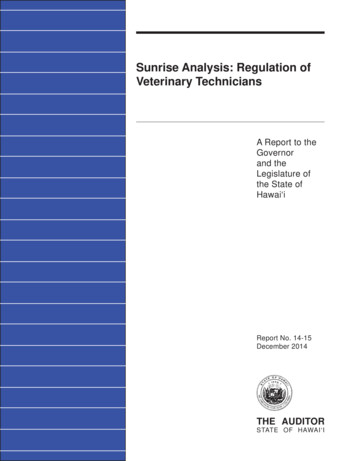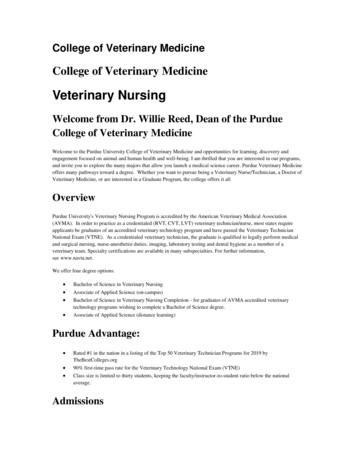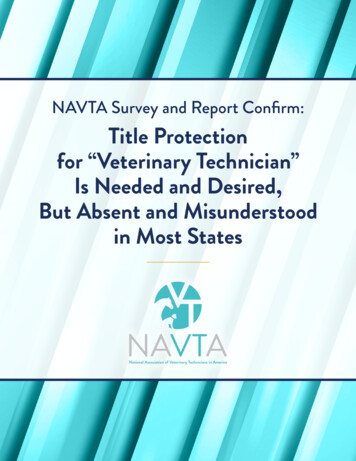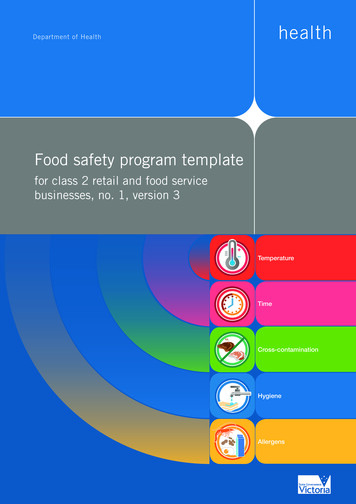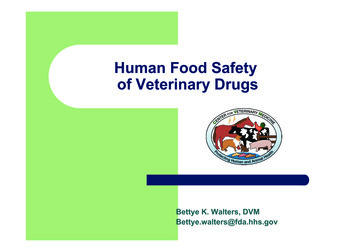
Transcription
Human Food Safetyof Veterinary DrugsBettye K. Walters, DVMBettye.walters@fda.hhs.gov
Pertinent International Resources Organization for Economic Co-Operation andDevelopment (OECD) Understanding the Codex Alimentarius IPCS Principles and Methods for the RiskAssessment of Chemicals in Food–Chapter 8 MRLs for Pesticides and Veterinary Drugs
Pertinent International Resources CAC/ GL 71-2009 GUIDELINES FOR THE DESIGN ANDIMPLEMENTATION OF NATIONAL REGULATORYFOOD SAFETY ASSURANCE PROGRAMME ASSOCIATEDWITH THE USE OF VETERINARYDRUGS IN FOOD PRODUCING ANIMALS
OIE Guidelines on VeterinaryLegislation 9.1 Veterinary legislation should address thefollowing elements: i) avoiding the presenceof harmful residues in the food chain; ii)ensuring that the use of veterinary productsdoes not give rise to human health risk9.3 ii) Veterinary legislation shouldaddress establishment of the withdrawalperiods and maximum residue limits forveterinary products as appropriate
Definition of Residue: Any compound present in the edible tissuesafter treatment with the drug. Includes parent drug, metabolites, and anysubstance formed in or on food.
Definition of MRL Maximum concentration of residue resultingfrom the use of a veterinary drug that isrecommended by the Codex AlimentariusCommission to be legally permitted orrecognized as acceptable in or on a foodMRLs recommended by JECFA to theCCRVDF are expressed as concentrations ofthe marker residue
Definition of Marker Residue A residue whose concentration decreases in aknown relationship to the level of total residues intissues, eggs, milk or other animal tissues. A specificquantitative analytical method for measuring theconcentration of the residue with the requiredsensitivity must be available.JECFA uses residue depletion studies with radiolabelledparent drugs in target animals to determine the markerresidue
General principles for evaluating safetyof compounds in food producinganimals Determine whether each food additive, new animaldrug, or color additive proposed for use in foodproducing animals is safe for those animals andwhether the edible products derived from treatedanimals are safe.US EXAMPLE: Sponsor of the compound isrequired to furnish to FDA the scientific informationnecessary for demonstrating that the residues of thesponsored compound in the edible products oftreated animals are safe.
U. S. EXAMPLE: Foodborne SurveillanceCollaborative effort among FDA, USDA,and CDC which monitors antimicrobialsusceptibility patterns of zoonotic entericbacteriaFSIS tests selected meat, poultry, andegg products for microbial hazards ofpublic health concernVoluntary data-gathering programwhich tests fresh fruit and vegetablesfor targeted foodborne pathogensand indicator organismsNetwork of public health and regulatorylabs that perform molecular subtypingof certain foodborne pathogensCollaborative effort among CDC, USDA-FSIS,FDA, and participating state health departments
U. S. EXAMPLE: FDA Veterinary DrugApproval Process Veterinary drugs are evaluated for: Effectiveness TargetAnimal Safety Environmental Safety Chemistry, Manufacturing, and Controls Labeling Human Food Safety
Human Food Safety Evaluation We answer the question - When are theedible tissues from an animal treated with adrug safe for humans to consume?
U. S. Example: OrganizationalstructureCenter forVeterinary MedicineOffice of New AnimalDrug EvaluationsDivision ofHuman ial FoodSafety Team
Edible tissues for all food animals: MuscleLiverKidneyFat/SkinMilkEggs
U. S. EXAMPLE: Human Food SafetyAssessmentToxicology(ADISafe Concentration)Microbial Food SafetyAntimicrobial resistance(human intestinal flora)Residue Chemistry(Tolerance/MRL,Regulatory MethodWithdrawal Period,Milk Discard Time)
VICH Safety Guidelines Implemented as FDA/CVMGuidance for Industry (GFI)VICH GL#SubjectGL33GFI 149General Approach to TestingGL31GFI 147Repeat-Dose (90-day) Toxicity TestingGL37GFI 160Repeat-Dose (Chronic) Toxicity TestingGL22GFI 115Reproductive Toxicity TestingGL32GFI 148Developmental Toxicity TestingGL23GFI 116Genotoxicity TestingGL28GFI 141Carcinogenicity Testing
VICH Safety Guidelines Implemented as FDA/CVMGuidance for Industry (GFI)VICH GL#CVM GFI#SubjectGL46GFI 149Metabolism Study to Determine the Quantityand Identify the Nature of Residues (MRK)GL47GFI 147Comparative Metabolism Studies inLaboratory AnimalsGL48GFI 160Marker Residue Depletion Studies ToEstablish Product Withdrawal PeriodsGL49GFI 115Validation of Analytical Methods used inResidue Depletion Studies
VICH Safety Guidelines Implemented as FDA/CVMGuidance for Industry (GFI)VICH GL#GL36CVM GFI#SubjectGFI 152Evaluating the Safety of Antimicrobial NewAnimal Drugs with Regard to TheirMicrobiological Effects on Bacteria ofHuman Health ConcernGFI 159Studies to Evaluate the Safety of Residuesof Veterinary Drugs in Human Food: GeneralApproach to Establish a Microbiological ADI
Human Food Safety AssessmentToxicology(ADISafe Concentration)Microbial Food Safety(human intestinal flora)Residue Chemistry(Tolerance/MRL,Regulatory MethodWithdrawal Period,Milk Discard Time)
Toxicology Assessment Identify and characterize any potential adversehealth effectsRisk Hazard X Exposure
Toxicology Testing Define the biological effect(s) of a compoundand its quantitative limitsAll testing is conducted through oralexposure in surrogate laboratory speciesTested substance: parent drug substance, itsmetabolite(s), excipient(s), or formulateddrug product
Toxicology AssessmentThe general approach is toEstablish a human Acceptable Daily Intake(ADI) level for total drug residues in edibletissues based on toxicology testingADI - An estimate by JECFA of the amount of aveterinary drug, expressed on a body weight basis,that can be ingested daily over a lifetime withoutappreciable health risk (standard person 60 kg)
Food Basket Assumption that all of eachedible product is eaten eachday for lifetimeEstimated Daily Intake (EDI)Total radiolabeled residuesfor each edible tissue X foodbasket contribution todetermine when totalexposure will be below theADIEdibleProductFoodConsumptionMuscle300 gLiver100 gKidney50 gFat (fat/skin)50 gEggs100 gMilk1.5 LHoney20 g
Recommended Testing ApproachToxicologyTestingBasic ToxicologyStudiesSubchronic, ChronicReproductive, DevelopmentalA battery of Genotox StudiesAdditionalToxicologyStudiesEffects on human gut flora,CarcinogenicityImmunotoxicityNeurotoxicity, pharmacological effectsSpecialStudiesMode of action
Summary Toxicology human food safetyassessment identify and characterize anypotential adverse health effects that maybe caused by the consumption of drugresidues in edible tissues of foodproducing animals.As a result of toxicology human foodsafety assessment, a human ADI for totaldrug residues is assigned.
Human Food Safety AssessmentToxicology(ADISafe Concentration)Microbial Food Safety(AntimicrobialResistance,human intestinal flora)Residue Chemistry(Tolerance/MRL,Regulatory MethodWithdrawal Period,Milk Discard Time)
Objective of Residue Chemistry Studies Mitigate the hazard identified in the toxicologyor microbial food safety studies by controllingexposure with assignment of MRL andwithdrawal period.Risk Hazard X Exposure
Establishing MRLsCodex Alimentarius Global reference established by FAO and theWHO (Codex Alimentarius Commission)Collection of standards, codes of practice,guidelines and other recommendationsFormulating and harmonizing food standardsLegal parameters for World TradeOrganization AgreementsCCRVDF
JECFA Joint Expert Committee onFood Additives First joint FAO/WHO Conference on Food Additivesin 1955 led to creation of JECFAInternational expert scientific committeeEvaluation of contaminants, naturally occurringtoxicants and veterinary drugs in food2600 food additives, 50 contaminants and naturallyoccurring toxicants and residues of approximately 95veterinary drugs
What does JECFA do for residues ofveterinary drugs in food? Elaborates principles for evaluating their safety andfor quantifying their risksEstablishes ADIs and other guidance values foracute exposureRecommends maximum residue limits for tissuesand identifies target tissuesDetermines appropriate criteria for and evaluatesmethods of analysis for detecting and/or quantifyingresidues in food
Criteria for JECFA to recommendMRLs Veterinary drugs proposed for evaluation by JECFAshould be–– registered by national or regional authorities, commerciallyavailable with established labelused according to the Good Practice in the Use ofVeterinary Drugs (GPVD)GPVD - officially recommended or authorized usageincluding withdrawal periods, approved by nationalauthorities, of veterinary drugs under practicalconditions
Where are MRLs found? ata/MAS-RVDF 2006 e.pdf drugs/classes.html
Tissue Residue Depletion StudyObjective: Run a residue depletion study underfield conditions and use the determinativemethod to measure how long it takes themarker residue to deplete to below the MRL- determine the withdrawal period ormilk discard time
Definition of Withdrawal Period/MilkDiscard Time The time interval between the lastadministration of a sponsored compound andwhen the animal can be safely slaughteredfor food or the milk can be safely consumed. Calculated by using the 95th percentilestatistical tolerance limit with 95% confidencefor JECFA The withdrawal period will appear on theproduct label
Total Residue and Metabolism StudyDefinition of MARKER RESIDUE The parent drug or metabolite in a known relationship to theconcentration of total residue in the edible tissue Tilmicosin (parent) 22,23-dihydroavermectin B1a (metabolite) Relationship between the concentrations ofthe marker residue and total residues isusually established at representative timepoints during depletion in a study using druglabeled with a radioactive isotopeU. S. EXAMPLE: Marker residue and target tissue are listed in21 CFR 556.
Tissue Residue Depletion Study Target food animals (usually market size)Dosed according to proposed product label–– highest doselongest duration of treatmentSample animals at timepoints after drug iswithdrawnCollect and analyze tissues for drugresidues
U. S. Example: Software fordetermining milk withdrawal time SAS-based program availableFDA, CVM will share system with interestedpartiesRequires full suite of SAS*Depletion criteria for US different from thoseused by most registration authorities
Residue Monitoring Plan GUIDELINES FOR THE DESIGN AND IMPLEMENTATION OFNATIONAL REGULATORYFOOD SAFETY ASSURANCE PROGRAMME ASSOCIATEDWITH THE USE OF VETERINARYDRUGS IN FOOD PRODUCING ANIMALS
Programmes for the control of residues ofveterinary drugs in foods should: i. Be based on risk using realistic risk profilesassessed as reasonably likely to be associated withfood derived from the relevant productions system(s)ii. Be prevention focused based on the realistic riskprofiles associated with the probable or known useof approved, non-approved and prohibited veterinarydrugs in the production systemiii. Include regulatory measures proportionate to therelative human health risk associated with thesehazards compared with other food-associatedhazards
Programmes for the control of residues ofveterinary drugs in foods should: iv. Ensure all parties involved in the production, marketing andprocessing system of the animals and/or the food productsderived from them are held accountable to ensure that unsafeanimal products will not be sold as a result of their action orinactionv. Recognise that pre-harvest controls and practices are theprimary means for ensuring safe foodvi. Recognise that the primary role of audits and samplingprogrammes is to verify the implementation and effectivenessof the pre-harvest controls and practicesvii. Focus on system and population based assurancesviii. Be cost effective and have the support of stakeholders
Violative Drug Residues What are violative drug residues and how arethey caused?What are the health concerns with violativedrug residues?Goal of monitoring program is to keepviolative residues out of food supply
Violative Residues Use of approved drugs but residues areabove MRL’s Product was mis-usedLabel directions were not followed: incorrect dose,treatment duration, route of administration, withdrawalperiodResidues from the use of unapproved drugs
Extralabel use Actual use or intended use of a drug in ananimal in a manner that is not in accordancewith the approved labeling––––Use in species not listed on the labelUse for indications not listed on the labelUse at dosage levels, frequencies, or routes ofadministration other than those on the labelDeviation from the labeled withdrawal time basedon these different uses
Veterinary Drugs with High Public HealthConcern - Critically Important Antimicrobials Fluoroquinolones (ELDU prohibition), thirdgeneration cephalosporins, and macrolides– enrofloxacin (Baytril), ceftiofur (Naxcel, Excede),tylosin (Tylan)Are considered ‘critically important’ totreating some human infections.Concern about the development ofresistance to these drugs by microorganismsresulting in treatment failure in humans
Summary Veterinary drugs are evaluated for human foodsafety using a risk assessment approach.MRLs are established as the legal safety limit ofresidues in edible tissues.Human food safety concerns are associated withconsuming edible tissues containing violativeresidues.
Presentation prepared by: Bettye. K. Walters,DVM; Julia A.Oriani, PhD; John A. Kadavil, PhDHeather Harbottle, PhDTong Zhou, PhD; Frank O. Johnson, PhD
Guidance for Industry (GFI) VICH GL# Subject GL33 GFI 149 General Approach to Testing GL31 GFI 147 Repeat-Dose (90-day) Toxicity Testing GL37 GFI 160 Repeat-Dose (Chronic) Toxicity Testing GL22 GFI 115 Reproductive Toxicity Testing GL32 GFI 148 Developmental Toxicity Testing GL23 GFI 116 Genotoxicity Testing GL28 GFI 141 Carcinogenicity Testing
